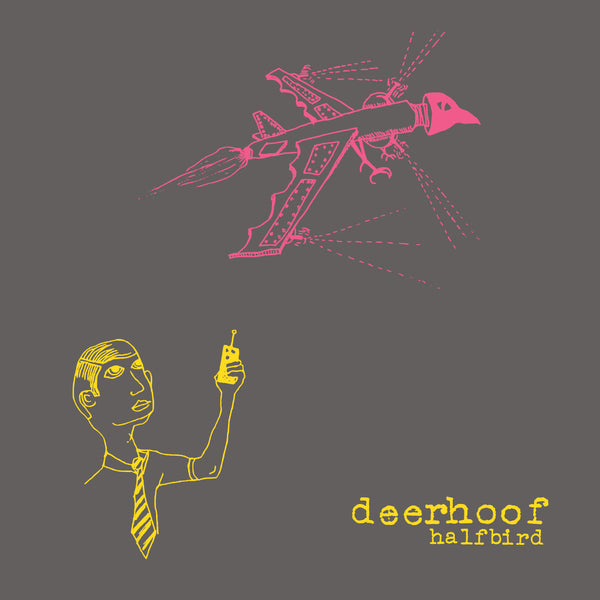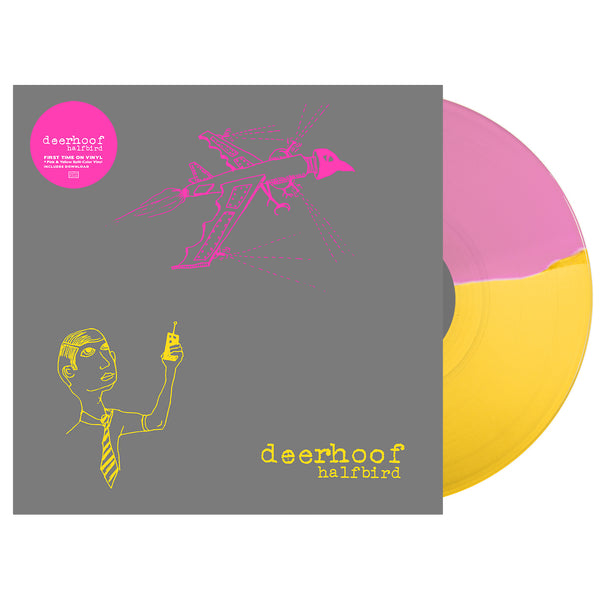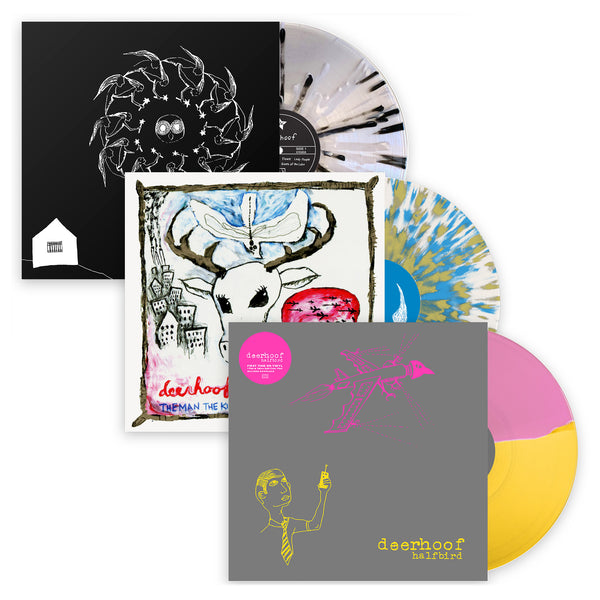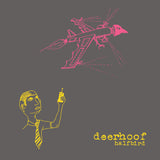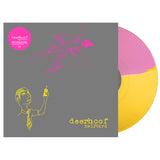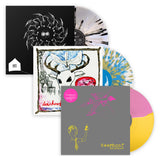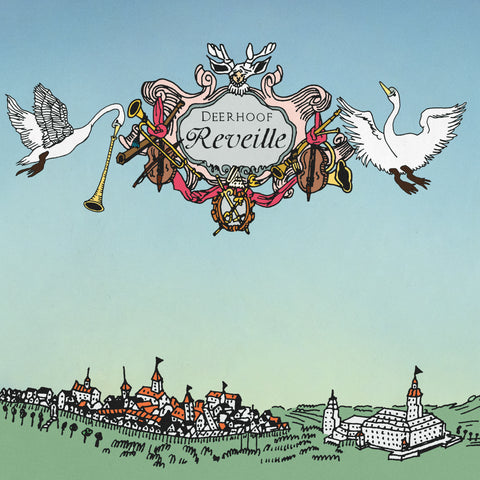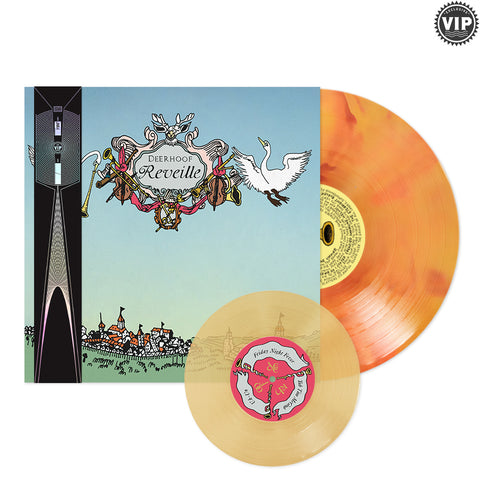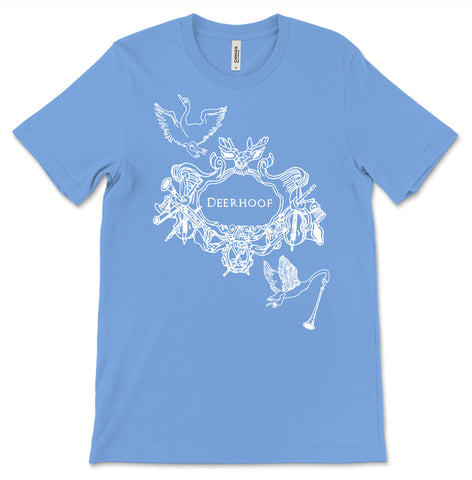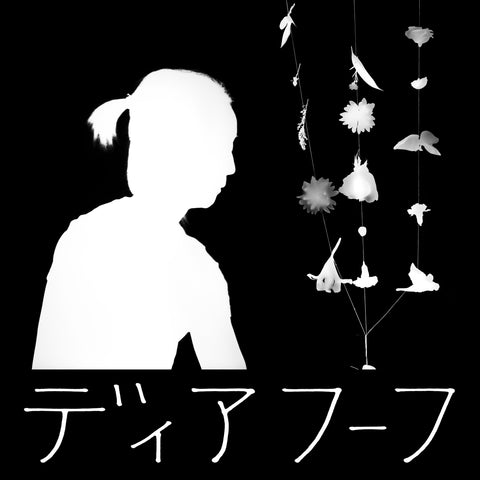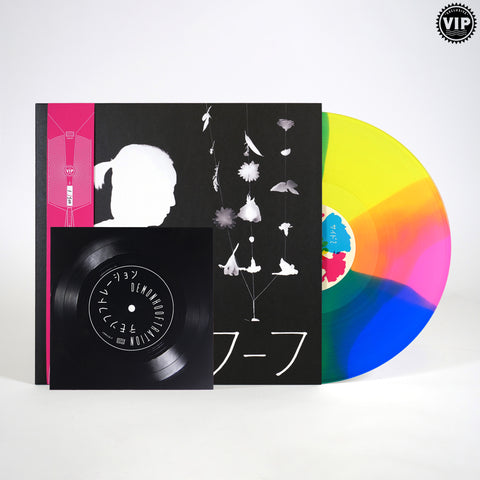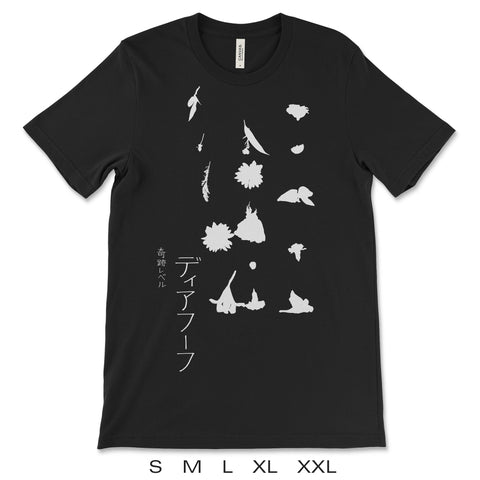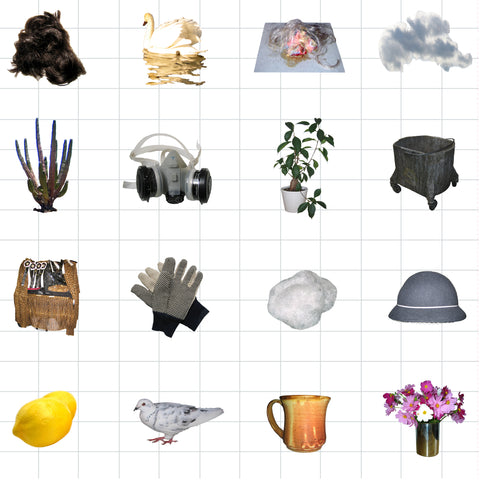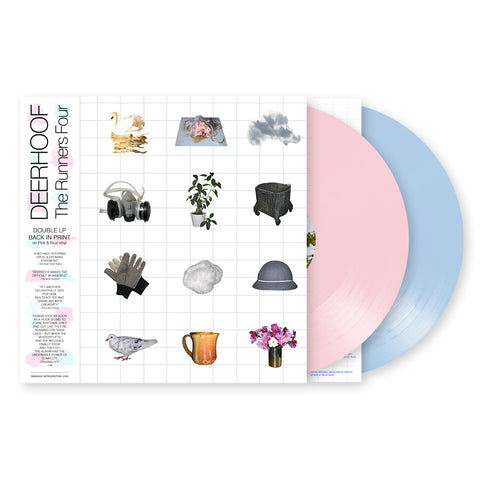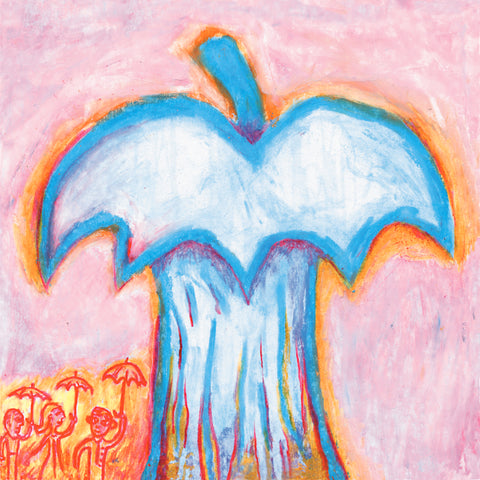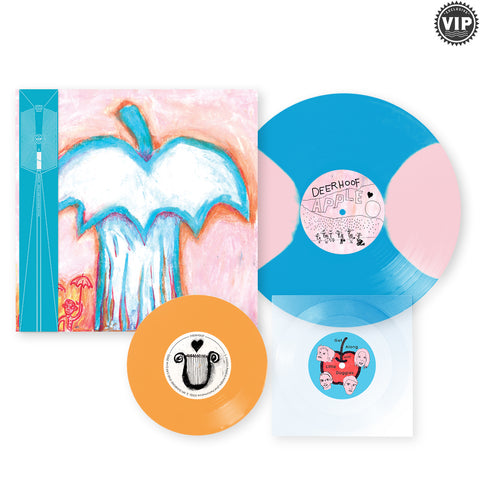$ 22.00 USD
SOLD OUT
- Halfrabbit Halfdog
- Six Holes on a Stick
- Red Dragon
- Trickybird
- The Man The King The Girl And The Spider
- Witchery Glamour Spell
- Queen Orca Wicca Wind
- Sunnyside
- Carriage
- Littleness
- Xmas Tree
- Rat Attack
- The Forty Fours
- Halfmole Halfbird
“If one were to connect a lot of sentimentality to dividing up groups of one-hundred into fours, and to have this kind of romance about arithmetic, then I would say we have reached some kind of milestone.” - Greg Saunier
The perennially beloved and wonderfully indefinable art-pop explorers Deerhoof are turning 25 this year. To celebrate the occasion, three labels closely associated with Deerhoof’s career (Kill Rock Stars, Polyvinyl, JNR) are each reissuing one of the band’s first three LPs. While today Deerhoof are universally praised for their significant contributions to 21st Century rock and roll, in 1994 they were just beginning to develop the sound that would later inspire Pitchfork to label them ”the best band in the world.”
“Like a lot of bands and projects, it's pretty hard to pin down exactly when the anniversary would be,” says Deerhoof drummer and co-founder Greg Saunier. According to Saunier, Deerhoof started as the solo recording project of bassist/guitarst Rob Fisk. “The first ever Deerhoof thing was a cassette Rob made. He did a run of five copies, and I still have my copy of that original Deerhoof release.”
“I’d been playing with Rob since 1992, but in a different band called Nitre Pit,” Saunier continues. “We used to come in an hour early before Nitre Pit practiced. I remember one time at the end of the hour we were just staring at each other stunned. Suddenly freed from the structure of any song, we realized there was so much more rapport when it was just the two of us playing totally freely and as loud as we possibly could.”
The addition of Satomi Matsuzaki as vocalist was the next major step in Deerhoof’s evolution. “When we'd play we were just flailing and convulsing around on our instruments,” Saunier shares. “It was impossible to keep our mouths near a microphone, let alone sing into one. We realized that we really needed to get a singer.”
Matsuzaki arrived in San Francisco from Japan in 1995 to attend college. She was tipped off by a mutual friend that Deerhoof was in search of a vocalist. Though she had no prior experience working in music, she agreed to meet the band for an audition. “Not only had Satomi not been in a band before, she had no musical experience whatsoever outside of learning the recorder in middle school,” Saunier reflects. “But when she heard how chaotic we were she figured she couldn't make the band any worse than it already sounded. [laughs]”
The stark simplicity of Matsuzaki’s vocal contributions provided a perfect foil to Fisk and Saunier’s over the top style. “Within seconds of hearing Satomi sing I knew instantly it was what had been missing from our band,” Saunier says. “We had a tour booked ten days after Satomi joined the band. Suddenly, the three of us were on tour, we were a band.”
Matsuzaki’s lack of experience did not deter her confidence. “It was a noise band, so I figured I could just do whatever I wanted. I moved to San Francisco to go to school, and it sounded like a fun afterschool activity.” But she was a bit taken aback by the duo’s often eccentric D.I.Y. work style. “I thought we'd have a practice space, but we ended up practicing in a kitchen. It was a small kitchen, and there was a big cat, and a big dog who were always looking for food. It was so crowded. Greg was playing drums with chopsticks and Rob was playing bass with a cow hoof.”
With the addition of Matsuzaki, Deerhoof quickly outgrew their roots in San Francisco’s noise scene. While Deerhoof retained the unrestrained creative freedom of the noise genre, they embraced the structured songcraft of pop music. “Deerhoof sort-of picked up right when Nirvana ended and we felt like a grunge band or a rock band,” Saunier shares. “We never fit well in the noise scene. We'd come out and have melodies, and it would go to a chorus, and we'd have cute lyrics about animals and flowers and stuff. But the reality is we didn't fit well on any kind of pop bill either, our music was too chaotic.”
Deerhoof’s strikingly individual sound may have been an impediment during the group’s early years, but it would soon propel the band to international notoriety.
THE MAN, THE KING, THE GIRL - 1997
Although Deerhoof had already released a handful of vinyl and cassette oddities, The Man, the King, the Girl is officially acknowledged as the group’s debut album. The recording features the early Deerhoof core unit of Rob Fisk on bass and guitar, Greg Saunier on drums, and Satomi Matsuzaki on vocals.
The opportunity to record The Man, the King, the Girl came about through the band’s relationship with Kill Rock Stars, Deerhoof had released a single with the label in 1995. “Our seven inch was anything but a smash hit,” Saunier observes. “If that was our trial period with Kill Rock Stars, I can't imagine what about the results of that single convinced them it was time to do a full length CD. But somehow within the logic of their decision making, for which I will forever be in their debt, they decided that Deerhoof should have an album.”
“We didn't really know what we were doing,” Saunier continues. “But once we realized we were gonna be making an album we would record all our practices and try to find magical moments. Funny things would happen by accident that would give something special to a particular song. Something that couldn't ever be repeated. We'd get home after recording, and try to find all the most magical moments from the stuff we'd recorded. Making that first album was probably two years of compiling zillions of those tapes.”
The Man, the King, the Girl saw Deerhoof consciously moving away from their improvisatory noise music roots. “So much of our music was in the moment,” Saunier shares. “But we had songs, and we thought of them as pop songs. We were trying to make things that were really catchy. We weren't trying to make it lo-fi. We were trying to make it hi-fi. We were trying to make it sound powerful. We'd listen through and try to pick the best moments, and what we thought were the catchiest moments, and the most hi-fi moments. That's how we put together the first CD.”
For Satomi Matsuzaki the album remains a highpoint in the band’s discography. “It's one of my favorite Deerhoof albums. It's chaotic, but it sounds so real, and our characters are so out there.”
HOLDYPAWS - 1999
During the recording of Holdypaws, Saunier thought he’d discovered a foolproof formula for high-fidelity pop perfection, but things didn’t turn out as planned.
“Our friend Bob got a computer,” Saunier recalls. “Bob had an early version of Pro Tools. You know, it's very widespread now and everybody has GarageBand, or Ableton, or whatever — but this was an early model. Bob agreed to allow Deerhoof to come to his basement and try to record Holdypaws. He made this agreement after seeing us play live and thinking we were very fun loving and spontaneous, and surely we'd come in and blow through an album's worth of songs and be done in an hour. That’s how our shows were, they were so spontaneous and fun.”
Unfortunately for Bob, the Holdypaws sessions were anything but spontaneous as Saunier obsessed over every aspect of the recording process. “In our minds we wanted to record at his place because we thought we'd finally found the magic bullet of high-fidelity sound. So we came in there with the most nit-picky attitude. We'd never done any computer recording before, but we just waltzed in as though we knew everything about how to do it. We took a perfectionist approach and played the songs in the complete opposite of how our live shows were, and completely the opposite of The Man, the King, the Girl. There was no noise on Holdypaws, no improvisation, there was no chaos, and there was every intention to be as hi-fi as possible. We wanted to make a clear, perfectly-sounding, and perfectly-performed indie rock pop record.”
Along with the new recording techniques Deerhoof completely reinvented their approach to performing on the Holdypaws sessions. “I didn't even play drums on that album,” Saunier observes. “I sampled one bass drum hit from Ringo Starr's drum solo on Abbey Road and loaded it into a keyboard Bob had. Then I took the snare drum hit from what was then the new record from Keith Richards And The X-Pensive Winos. So the drums on Holdypaws are just two keys on a keyboard — one was the bass drum, and one was the snare. I was just completely convinced that was the way to create a hi-fi record, because every single drum hit would sound exactly the same on every song, and would be the perfect tones.”
Holdypaws also marked Satomi Matsuzaki’s first appearance on bass, and the arrival of Kelly Goode on keys. “We weren't using any kind of traditional music vocabulary,” Saunier remembers. “Although Kelly didn't play the keyboard at all, we felt it would really help our sound if we added her. But the only keyboard we had was a Casio VL-Tone that I had gotten as a Christmas present in the early '80s. It was very small, it only played one note at a time, and it doubled as a calculator. Because it was a calculator, every key had a number. But they weren't really even keys, they were just little black and white buttons that were sort-of arranged to look a little like a piano keyboard. So each key had a number, and the way we would figure out these songs was to give Kelly a sequence of numbers of the buttons to press and then the melody would come out right. At the same time Satomi had decided to teach herself to play bass. She had a collection of animal stickers which she put on the neck of the bass, one for each fret. So when we were figuring out the songs we'd be like, 'You hit bear three times, and then go to lion.' [laughs]”
But according to Saunier, Bob was growing weary of Deerhoof’s endless experimentation. “As we were mixing it Bob finally got impatient with me. He had kids, and I was coming over to his house and doing all-nighters on his computer too many times. After a week or so, he was like, 'We're finishing this today.' I was like, 'What? I'm nowhere close to getting this thing right!' [laughs] So in the end it was a completely panicked mix. We had to make the final mix so fast, and I didn't feel like we were ready at all.”
Holdypaws remains a fascinating gem in the Deerhoof catalog. “I’ve always felt the charm of the record was in its failed attempt to be a perfectly recorded mainstream rock record” Saunier adds. “I don't know what we thought, maybe that it would sound like Sheryl Crow or something? [laughs] But it so did not turn out like that.”
HALFBIRD - 2001
“Actually Halfbird was going to be our second album,” Saunier says. “The reason Halfbird came out as our third album instead of our second is because it took four years of tinkering on the four-track to get it ready for release.”
Halfbird represents the apex of Deerhoof’s struggle to pull hi-fi sound out of lo-fi gear. “Two of the three LPs that are being reissued now were recorded on the same broken Tascam four-track cassette machine,” Saunier shares. “It was so much trouble to even get it to record a sound. It would keep switching off because the power thing was broken and the inputs didn't work.”
“When our first album completely bombed, we were determined to do a better job,” Saunier recalls. Though Deerhoof were stuck recording on the aforementioned broken Tascam, Saunier valiantly tried to improve other aspects of the recording process. “We borrowed some better amps and microphones. We tried to do it right. I'd read something in a magazine about how your supposed to mic a bass drum and we’d try it. We recorded all the loud songs in one day with a couple borrowed microphones in a borrowed room. We recorded all the quiet songs in the front of our apartment while our roommate wasn't home. It was all one take per song and that's what we had to work with.”
But Halfbird would spend several years mired in post-production limbo. “We gave up on it so many times, and then came back to it thinking maybe it could work,” Saunier says.
Matsuzaki recalls Saunier’s obsession with salvaging the project. “For months Greg would sit in front of the Tascam four-track all day long just touching all these knobs, Matsuzaki says. “I’m from Japan, and I thought there's so much technology out there, I was like, 'Wow, Greg really believes in this machine.’ It was a mystery to me and I wondered, ‘Why don't we just buy something else?' Greg tried so hard. The machine itself showed wear from how much Greg was working with it.”
“I’ll never get those years back that I spent on that Tascam,” Saunier laughs. “I was literally starting to experience sanity issues from obsessing over that tape machine.”
Eventually Deerhoof succeeded in bringing Halfbird to life. But by the time the album was issued in 2001, Saunier says that Deerhoof was in a difficult place. “There was an existential crisis every week or so. In the four years it took to complete Halfbird Rob and Kelly quit, and it seemed like the band was over. It had become such a pain, and we were so amazingly unsuccessful in everything we attempted. All of our CDs lost money, all of our tours lost money, and this was happening when the first of San Francisco's tech booms was starting and everything was getting really expensive. Rob started thinking, 'What in the world am I doing?' We all had those doubts constantly. It seemed like a silly way to be wasting your life away, huddled over a four-track machine and playing to the same eight people at every show. It felt like it was going nowhere, and meanwhile the cost of living was skyrocketing.”
“A new phase of the band was about to start,” Saunier reflects. Deerhoof’s next album Reveille would receive remarkable critical acclaim, being included in 2002-best-of lists published by Pitchfork and the New York Times. Deerhoof were on their way to indie rock glory and fame. “Like anybody's life, so much of Deerhoof’s story has been built around accidents and coincidences,” Saunier shares. “Everything just kept falling into place in a way that allowed us to get things done.”
Both Matsuzaki and Saunier feel Deerhoof’s early work deserves a new listen. “I felt lucky this year to be able to go back to those first three records and hear what they actually sounded like,” Saunier says. “When those records are mentioned they're usually referred to as our lo-fi/noise albums. So it was really great for me to hear those records again and realize they were every bit as poppy as anything we've done since.”
“I think these three albums are Deerhoof's most raw and real albums,” Matsuzaki adds. “These albums are almost like science fiction to me. We had all these fantasies about what we wanted to do musically and we were struggling to meet that reality. But I feel like the labels and people we worked with believed in our weird fantasy. I still believe in that fantasy and after 25 years I still like these albums. I hope people will enjoy too.”


